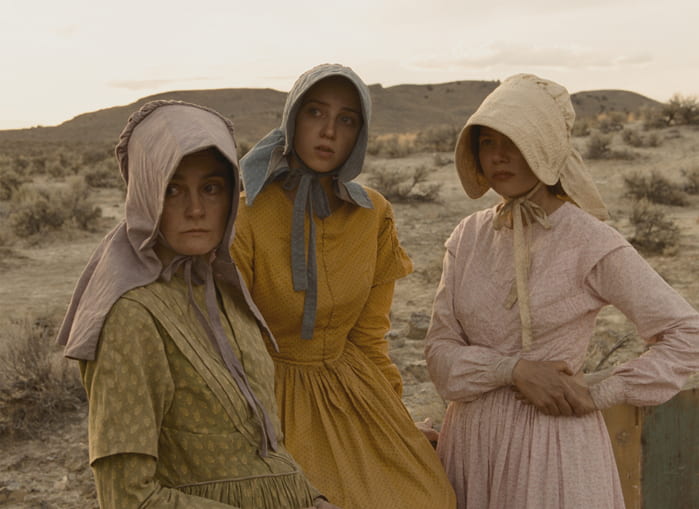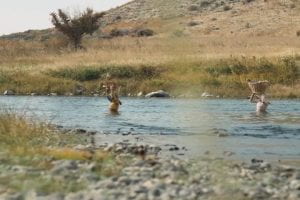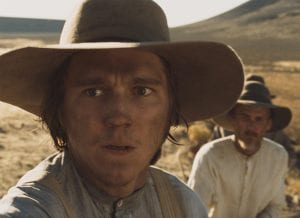
Last month The New York Times Magazine ran a piece titled “The Quiet Menace of Kelly Reichardt’s Feminist Westerns.” In it the author argues that, although Reichardt has only made one “true” Western, all of her films, in fact, can be considered revisionist Westerns that promote the possibility of a quiet, often lost, and in some way defeated, female lead. For these characters civilization does little to provide them with the justice that is promised, and their lonesome, often roaming, nature may strike a chord with those who remember the John Wayne or Clint Eastwood Westerners that have become “classics.”

Although I’m not at all against this claim — that all of Reichardt’s films could be considered Westerns — I do have a special place in my heart for Meek’s Cutoff, that one “true” Western of hers that began screening at film festivals in 2010. As a film scholar who studies Westerns, and particularly those containing genre-subversive female characters, this film is a go-to for illustrating my research interests. However, it is also a film that knows what it is, despite any arguments that it could not possibly be so. This adamant declaration of a Western becomes all the more striking for its equally adamant shift in focus and composition. Following the travails of three settler families lost in the deserts of Oregon in 1845, Meek’s Cutoff provides little adventure, climax, or resolution. There are no shoot-outs, or cowboys versus Indians (although there is the conflict of a group of white settlers dependent upon a lone indigenous man); instead, the entire film is a struggle for survival — not a quest for glory, the “American Dream,” or vengeance.
Meek’s Cutoff is a slow, quiet, and sometimes inarticulate, trek through a space, a time, and a world we are rarely shown. Simultaneously lost in a seemingly endless land and trapped in the day-in and day-out struggle to get somewhere in a 4:3 frame, like the travelers, the viewer is made relentlessly uncomfortable. Yet, I find a beauty in this feeling, a view of the world that is not the mythological, the spectacular, or frankly, fair. It is a beauty in living without knowing what’s to come. It is a beauty in pushing forward, and perhaps not progressing, but surviving nonetheless. When dropped into this landscape, this world, the viewer can either give up or wade in, like the women into the river in the film’s initial sequence.
Because of the connection I have to this movie, and the deep appreciation I have for Reichardt’s style I am beyond excited for some of the upcoming events at the Indiana University Cinema. On December 2, Reichardt will be joining audiences as part of this semester’s Jorgensen Guest Filmmaker Lecture Series. Along with her Friday afternoon lecture, the Cinema will be screening a handful of her films (both old and new) as part of the “Kelly Reichardt: A Keen & Subtle Eye” series. Unfortunately, Meek’s Cutoff will not be a part of this group of films (as it screened at the Cinema in May of 2011); but don’t let this deter you from experiencing a rare and wonderful opportunity. Personally, I can say that resources like these make it a real treat to be studying film at Indiana University.
__________________________________________________________________________________________________________________
The following films will be screening in conjunction with Reichardt’s visit and the “Kelly Reichardt: A Keen & Subtle Eye” series: Old Joy (2006), Certain Women (2016), River of Grass (1994), Night Moves (2013), and Wendy and Lucy (2008).
Jorgensen Guest Filmmaker Lecture Series take place each semester at the IU Cinema. They feature the works and words of some of the most influential filmmakers. In the past, filmmakers like Werner Herzog, Ava DuVernay, MM Serra, Meryl Streep, and Kenneth Anger to name only a few have been a part of this series. Following Reichardt’s visit, the last series lecture of this semester will be an onstage interview with Julie Dash on Friday, December 9. This will also include screenings of Dash’s L.A. Rebellion Shorts and her feature Daughters of the Dust (1991) as a part of the IU Cinema series “Julie Dash: Daughters of the Dust 25th Anniversary.”

Katherine Johnson, currently a third year legacy PhD student in Communication and Culture, studies film and media, genre (particularly the Western), gender, and performance. She has a BA from the University of Wisconsin-Madison and an MA from NYU’s Tisch School of the Arts, and has been obsessed with film since the beginning.


